28th MARCH – 12th APRIL 2023
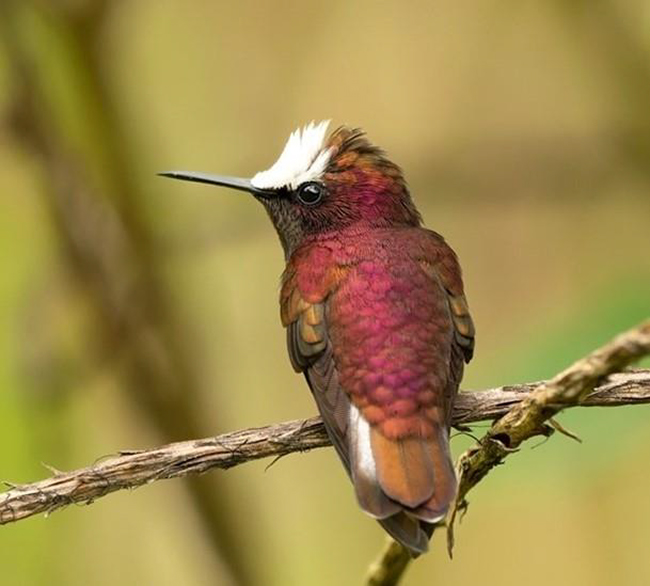
Snowcap was one of the highlights of the trip (photo Vernon Campos).
Overview
Our Complete Costa Rica Tour 2023 was really memorable, a great success and a pleasure to guide, having all the ingredients for a great trip. The driver was remarkable and friendly, and we had a fantastic group of fun-filled and friendly participants who were good travelers, hyper-enthusiastic, patient, and great spotters. The weather was favorable, the ground logistics well-planned and executed, and everything seemed to come together perfectly. We fully enjoyed our Costa Rica experience, and saw some of its most remarkable avifauna, including country endemics, regional endemics and some iconic Neotropical birds.
This was a dream trip for those who were setting foot in Central America for the first time, with birds such as the most-wanted and representative Resplendent Quetzal, Snowcap, Sunbittern, Sungrebe, Roseate Spoonbill, Jabiru, Scarlet and Great-green Macaws, Yellow-throated and Keel-billed Toucan, Turquoise-browed, Lesson’s and Keel-billed Motmots, Rufous-tailed Jacamar, Crested, Spectacled, Striped and Black-and-white Owls, American Dipper, Baird’s, Gartered, Black-headed and Black-throated Trogons, American Pygmy Kingfisher, Yellow-breasted Crake, Pinnated and Least Bitterns, White Hawk, Black Hawk-Eagle and Ornate Hawk-Eagle.
Additionally, we saw regional endemics and country targets such as Yellow-billed, Snowy and Turquoise Cotingas, Black-cheeked Ant Tanager, Flame-throated, Black-cheeked and Black-eared Warblers, Buffy Tuftedcheek, Ruddy Treerunner, Wrenthrush, Spangled-cheeked Tanager, Prong-billed Barbet, Lesser Ground Cuckoo, Nicaraguan Grackle, Nicaraguan Seed Finch, and many more. We also saw a fine selection of wildlife, from colorful frogs to mammals like the charismatic Brown-throated Sloth, Baird’s Tapir and Central America Spider Monkey.
Over the course of 17 days we explored from San Jose south to Golfito near the Peninsula de la Osa, through the Talamanca Mountains, to the Caribbean foothills and wetlands near the border with Nicaragua. We were serious about looking for birds, but this was well balanced with great relaxing times, enjoyable drinks and the euphoric feeling of being on tour. There was a good mixture of fun times, reflective thinking times, variety of habitats, breathtaking sunsets, starry nights, hot and cold weather, more drinks, Gallo Pinto again, and ending with the great satisfaction of having made new friends that one wants to tour with again in future.
Continue reading to get a glimpse of what our Costa Rica 2023 tour was like. Always “Pura Vida”!
Detailed Report
Day 1, 28th March 2023. Arrival in San Jose and transfer to the hotel Robledal
The group arrived in San Jose on different flights, with some of the participants deciding to arrive a day early to rest and avoid jet lag. We all met at Hotel Robledal in the afternoon, where we had the chance to do some preliminary birding around the gardens and get aquainted with each other. This was the first experience of Neotropical birding for some of the tour participants. Everyone was excited and happy. During our short birding session we saw Ferruginous Pygmy Owl, Rufous-backed Wren (also treated as Rufous-naped Wren), Clay-colored Thrush (Costa Rica’s national bird), Great-tailed Grackle, Melodious Blackbird, Tropical Kingbird, Great Kiskadee, Blue-grey Tanager, Hoffmann’s Woodpecker (named after Karl Hoffmann, a 19th century physician, naturalist and collector who lived in Costa Rica; other species named after him include Hoffmann’s Two-toed Sloth), and White-winged Dove. A joke turned our attention to the lyrics of US singer Stevie Nicks’ well-known song Edge of Seventeen, where the White-winged Dove is mentioned several times in the main chorus. This chorus became our anthem for our trip:
“Just like the white-winged dove
Sings a song, sounds like she’s singing
Ooh, ooh, ooh”
It felt great having such happy and enthusiastic tour participants. This tour was characterized by great cameraderie looking for birds, exploring new hunting grounds, and having fun together.
Costa Rica was calling!
Day 2, 29th March 2023. Birding Guacimo and transfer to Villa Lapas
This was one of the most amazing birding days of the entire trip. We started at 5am, birding the hotel grounds for an hour before breakfast was served. We had the same species from yesterday, and additionally spectacular views of Spot-breasted Oriole, Cinnamon-bellied Saltator, White-fronted Parrot, Inca Dove, Red-billed Pigeon, Summer Tanager, Green-breasted Mango, Yellow Warbler, Boat-billed Flycatcher and, at the last minute, great views of Plain-capped Starthroat. We checked the sky, looking for raptors, but we only got Black Vultures and some nice flocks of Finsch’s Parakeet (also called Crimson-fronted Parakeet) flying low above the garden.
We ate breakfast and met Luis, our driver for the whole tour, and Vernon, a local guide who joined us for the first week of the trip. We loaded the truck and left the hotel towards the Pacific slope, with the intention of birding the dry habitats along the Guacimo road. The weather was pleasant and the birding outstanding. We started with species such as Cinnamon and Blue-vented Hummingbird, Streak-backed Oriole, Blue Grosbeak, the beautiful Turquoise-browed Motmot (Nicaragua’s national bird), Olive Sparrow, White-lored Gnatcatcher, Variable Seedeater, Buff-throated Saltator, Lesser Greenlet, Great Crested Flycatcher, Greenish Elaenia, Nutting’s Flycatcher (named after Charles Nutting, a 19th century US zoologist), Mistletoe Tyrannulet, Streaked Flycatcher, Yellow-throated and Yellow-green Vireos, and Brown-crested Flycatcher. We managed to detect the elusive Banded Wren but only a few of us got silhouettes of this scrub skulker. We went calmly from one bird to another until excitement suddenly spiked with a Pacific Screech Owl found on a daytime roost. Other highlights included a nice flock of Broad-winged Hawks, our first encounter with Zone-tailed Hawk, Orange-fronted Parakeet, a King Vulture that flew by and gave decent views and, to crown the morning, spectacular views of the highly attractive Long-tailed Manakin (male). We also got good views of Southern Lapwing and Double-striped Thick-knee while scanning the open fields.
After this great session we arrived at a hot Villa Lapas, where we got lunch, had a short break and then went to explore the road above the lodge. During this afternoon session we managed to get great views of Fiery-billed Aracari, splendid Scarlet Macaws, Black-headed Trogon, Yellow-throated Toucan, Bat Falcon, Barred Antshrike, Dusky Antbird, Grey-headed Tanager, the first Green Honeycreeper, Grey-headed Chachalaca, Crested Guan, White-shouldered and Golden-hooded Tanagers, and Northern Mealy Amazon. It was one amazing bird after another, and then exhilaration exploded when everybody saw Painted Bunting very nicely at the side of the road. After a long but productive day, we retired to the lodge, enjoyed supper, completed checklists and got nice views of the Pacific race of the Red-eyed Tree Frog.
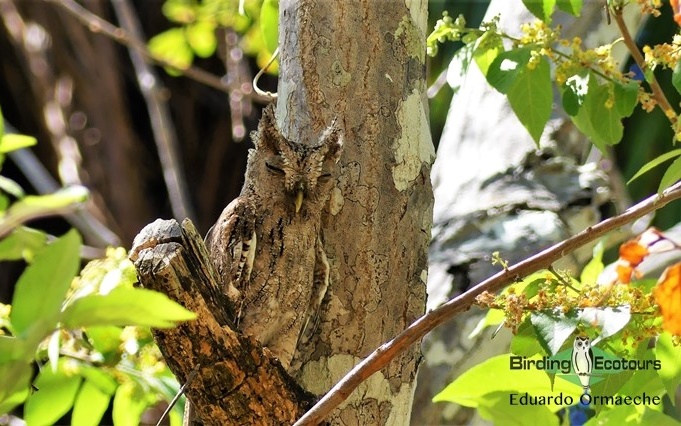
We saw Pacific Screech-Owl along Guacimo Road.
Day 3, 30th March 2023. Villa Lapas Lodge and Carara National Park
We started the first hours of the early morning birding around the lodge, before breakfast was served and the park opened. The lodge was strategically close to the park – only a few minutes’ drive. We got some nice species, including Black-faced Antthrush, Scaly-throated Leaftosser (watching leaves being tossed was a great experience for most), Streak-headed Woodcreeper, Golden-crowned Spadebill, Pale-billed Woodpecker, Lesson’s Motmot, Black-headed and Slaty-tailed Trogons, Buff-rumped Warbler, Red-crowned Ant-Tanager (which proved difficult for most of the participants and only a few got good views as the bird was skulking really hard), Orange-billed Sparrow, Grey-chested Dove, and Common Tody-Flycatcher building a nestnext to the bridge over the river. On the river we saw our first Bare-throated Tiger-Heron, Spotted Sandpiper, and Northern Waterthrush.
We went to the Carara National Park as soon as it opened to the public to explore the lek of the Orange-collared Manakin. We met another group at the lek itself, which is located at one side of the trail in a corner, so it was an interesting experience not being able to move much and letting the birds come to us. We all had great views and, especially when the other group left, we were able to get better positions and take photos of this beautiful looking bird.
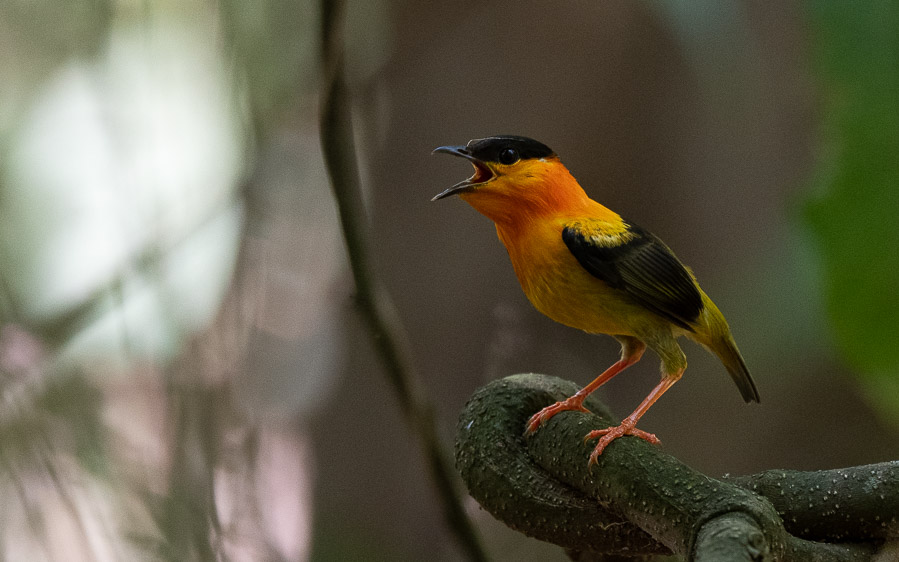
The most wanted Orange-collared Manakin was a highlight for all participants (photo Vernon Campos).
Other birds here included Grey-chested Dove, Cocoa and Streak-headed Woodcreeper, Scarlet Macaw, Squirrel Cuckoo, Blue-throated Sapphire (also known as Blue-throated Goldentail), Lesson’s Motmot, Pale-billed and Lineated Woodpeckers, Chestnut-backed Antbird, Wedge-billed Woodcreeper, Northern Royal Flycatcher, Sulphur-rumped Myiobius (also known as Sulphur-rumped Flycatcher), Eye-ringed Flatbill, the elusive Riverside Wren, and Chestnut-sided Warbler, which was seen throughout almost the entire trip. We tried hard for the Streak-chested Antpitta, but it remained calling distantly.
We returned to the lodge for lunch, some cold refreshments and some rest before returning to the park again. The afternoon was rather quiet, but we managed to get better views of the Chestnut-backed Antbird. We walked to the forest stream to wait for birds coming to bath. We managed to get nice views of the striking Red-capped Manakin (a couple of males and a female). They close the park at 5pm and we had to rush almost nonstop to be out of the park in time, but we were lucky to spot a couple of excellent birds on the way: the recently split Chiriqui Foliage-gleaner (split from Buff-throated Foliage-gleaner and named after a province of Panama), and a few of us managed to get Blue-crowned Manakin (male) right near the exit of the park.
We returned to the lodge and, after supper, tried for Parauque,which we saw nicely. A couple of us got silhouettes of Common Opossum high in the top of the trees.
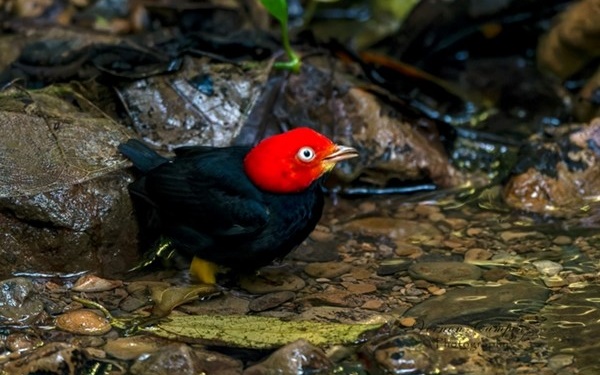
Red-capped Manakin taking a bath in the Carara National Park (photo Paul Newman).
Day 4, 31st March 2023. Tarcoles River and transfer to Esquinas
Today we had a long day ahead, and we were full of excitement and anticipation. We had our first boat trip of the tour, exploring the Tarcoles River. We saw many aquatic species this morning, including Green, Belted, and Ringed Kingfishers, Magnificent Frigatebirds, Great and Snowy Egrets, and Striated, Little Blue and Tricolored Herons. We saw a few Caspian and Royal Terns and had our first encounter with American Crocodile.
We explored the mangrove habitat in search of other species, including Boat-billed Heron, Yellow-crowned Night Heron, Anhinga, American Pygmy Kingfisher, Common Black Hawk, Scaly-breasted Hummingbird and Mangrove Warbler. We had great views of all these species. After a successful boat trip, we checked the mangrove habitat along the river shores to find American White Ibis, a second Turquoise-browed Motmot and the endemic Mangrove Hummingbird.
With this species in the pocket, we left Tarcoles to start the long drive to Esquinas Lodge in the south of the country, near the Golfito area. We arrived at our lodge in the afternoon, with enough time to check in to the rooms, become familiar with the surrounding area, have supper, complete checklists and enjoy a few drinks. It was another great and hot day in Costa Rica.
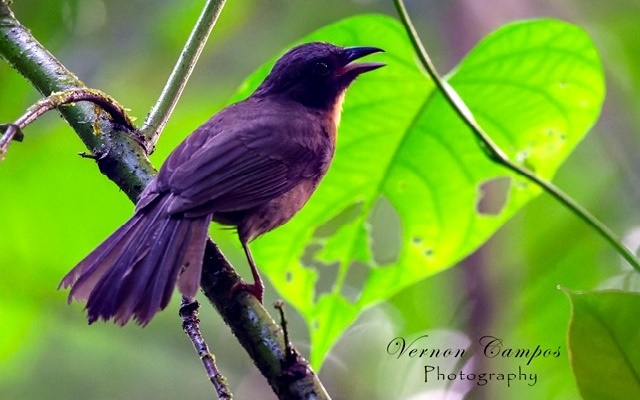
The endangered Black-cheeked Ant Tanager is an endemic of Southern Costa Rica.
Day 5, 1st April 2023. Esquinas Lodge
We started the day exploring the lodge trails, looking for one of the most important targets for this area, the endemic Black-cheeked Ant Tanager. Fortunately, we managed to find a small flock foraging in the dark forest understory, getting good views of this species. Costa Rica offers the chance to see three of the world’s five species of ant tanager (Habia). The other two speciesare endemic to Colombia and are often seen on our tours there. In the lodge we enjoyed views of Golden-hooded, Palm, Scarlet-rumped and Blue-grey Tanagers, and the widespread but often heard-only Bright-rumped Attila gave us good views. A pair of Great Curassow were seen daily around the lodge area. We enjoyed excellent views of both sexes. In addition to these we got Spot-crowned Euphonia, Grey-chested Dove, Rufous Piha, Scarlet-rumped Cacique, Yellow-throated Toucan, Fiery-billed Aracari, Black-striped Woodcreeper, Red-crowned Woodpecker, and Slaty-tailed Trogon.
Around the lodge clearing and the cabins we got hummingbirds such as Violet-headed Hummingbird, Stripe-throated Hermit, and Rufous-tailed Hummingbird. We relaxed during the afternoon and some participants stayed to enjoy the birds from their cabins whilst others went to the trails where they were rewarded with Baird’s Trogon and Blue-black Grosbeak.
After supper we went to bed early because we would be having a very early start tomorrow.
Day 6, 2nd April 2023. Puente Jimenez and Coto 45
We left the lodge around 4.30 am to be at Puente Jimenez by dawn. When we arrived, we got a quick box breakfast and stood at one side of the bridge waiting for our targets for the day, including the exquisite Yellow-billed Cotinga. We managed to see the usual aquatic species, such as Bare-throated Tiger Heron, American White Ibis, Spotted Sandpiper, and Green Heron. Other interesting species showed up nicely, such as Fiery-billed Aracari and Scarlet Macaw. We got a Mourning Warbler skulking in the vegetation below the bridge. Suddenly we were excited to see the cotingas flying by, and one perched but it was far from ideal against the light. While waiting we got the only Turquoise Cotinga of the trip, although distantly, we got great scope views of one male. Then the great moment came, and we got a male Yellow-billed Cotinga which came and perched in a tree which allowed us great views. This was most definitely most satisfying!
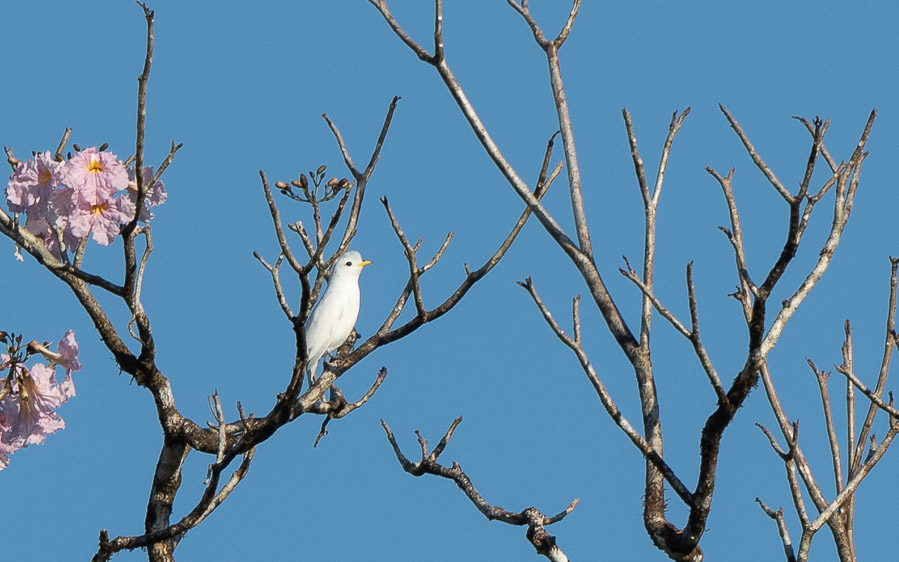
Yellow-billed Cotinga was a highlight of our trip (photo Vernon Campos).
In addition to these species we also got great views of Double-toothed Kite, Yellow-headed Caracara, Orange-chinned Parakeet, Red-lored Amazon, Black-crowned Tityra, Yellow-bellied Elaenia, Rusty-margined Flycatcher, Grey-capped Flycatcher, Southern Rough-winged Swallow and Grey-breasted Martin. Later, near La Gamba, we stopped in a small marshy area where we got Black-bellied Whistling Duck and Purple Gallinule. Then, looking for suitable habitat, we found Laughing Falcon, Striped Cuckoo, Pale-breasted Spinetail, White-winged Becard, Scrub and Tawny-crowned Greenlets, Fork-tailed Flycatcher, Bronzed Cowbird, Thick-billed Seed Finch, Yellow-bellied and Morelet’s Seedeaters, (named after Pierre Marie Arthur Morelet, a 19th century French naturalist and collector).
In the afternoon we drove through a huge plantation of oil palms to reach one of the last-remaining secondary growth habitats, where we found one of our two afternoon targets, the Sapphire-throated Hummingbird, which we all saw very well. We also had good views of a second Laughing Falcon, Black-striped Sparrow, Ruddy-breasted Seedeater, Fork-tailed Flycatcher, Smooth-billed Ani and Tropical Mockingbird.
We returned to the lodge, ate supper, completed checklists and then went out owling. We were rewarded with great views of the impressive Striped Owl, perched on telephone wires. We added more Parauques and, heading back to the lodge, we saw a Northern Raccoon.
Day 7, 3rd April 2023. Transfer to Savegre Lodge
We had a late start, getting ready for another long drive. Some of us showed up early in the dining room, to check feeders and catch up on any birds seen whilst everyone was apart. We also looked for Tayra, large mustelids which came to the feeders to steal bananas, a few of us saw them but never all of us as a group. Great Curassow was seen in the lodge clearing vicinity. After breakfast, we set off towards Savegre Lodge.
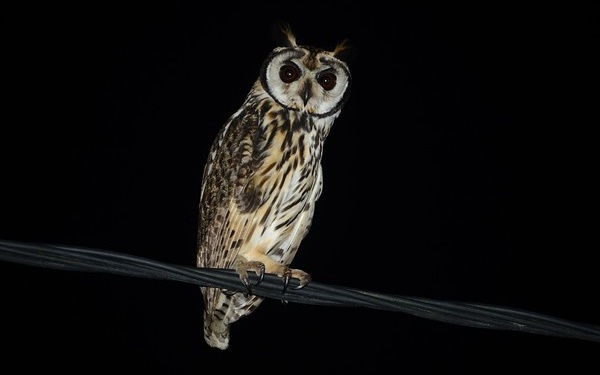
The impressive Striped Owl we saw at Esquinas Lodge (photo Alan Van Norman).
At San Gerardo de Dota, in the mountains, we said goodbye to our friend Vernon, who had travelled with us for the previous six days. The cool weather in the mountains was a very welcome change after a hot and humid week.
We arrived at the lodge and, after check-in, started heading to the cabins, when someone near the parking lot shouted “Quetzal” – the main target of the whole trip and one that often requires work to find. It was seen by some of us, and we were told that it had been feeding near the entrance along the main road. It was amazing that we got it without having left early in the morning, and the fact that it was seemingly unperturbed by the crowd.
Day 8, 4th April 2023. Savegre Lodge
The next morning, before breakfast, we went near the entrance and it didn’t take long before we got the most-wanted Resplendent Quetzal (male and female). This was our moment of glory, with the photographers trying for their best photos. Another great find near here was the Black-faced Solitaire, seen well by all of us. Very happy, we returned to the lodge for breakfast.
We enjoyed the bird feeders around the lodge clearing and parking area, with birds such as Slaty Flowerpiercer, Long-tailed Silky-flycatcher, and Rufous-collared Sparrow, and hummingbirds such as the common Grey-tailed Mountaingem (Lampornis cinereicauda, IOC considers this a country endemic different from White-throated Mountaingem, Lampornis castaneoventris, the species accepted by Cornel/Clements). We also got great views of Talamanca Hummingbird and Fiery-throated Hummingbird.
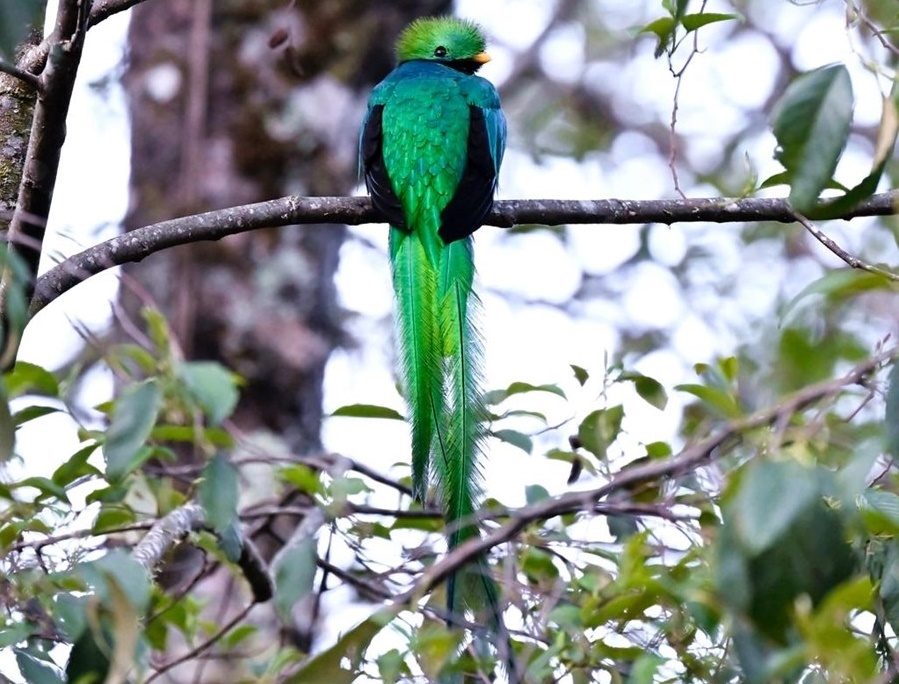
Seeing Resplendent Quetzal was a dream come true (photo Paul Newman).
After breakfast, we drove the 4×4 vehicle in the forest above the lodge, looking for specials. It was quiet when we arrived, but after a while we started getting birds such as Ruddy-capped Nightingale-Thrush, Black-cheeked Warbler, Large-footed Finch, Yellow-thighed Brushfinch, Ruddy Pigeon, Spot-crowned Woodcreeper, Ochraceous Wren, Ruddy Treerunner, Mountain Elaenia, Yellowish Flycatcher, Yellow-winged Vireo, Grey-breasted Wood-Wren, Sooty-capped Bush Tanager (also known as Sooty-capped Chlorospingus) which we saw repeatedly during the trip, the beautiful Collared Redstart, Black-throated Green Warbler, and Wilson’s Warbler. The excitement continued with a mixed feeding flock, with Flame-throated Warbler, Spangled-cheeked Tanager (well spotted by Jeanne) and a Buffy Tuftedcheek, which we followed along the forest trails to get good views of this bromeliad special. We had our first glimpse of Blue-throated Toucanet, and a glimpse of a flock of Barred Parakeet which crossed in the typical Barred Parakeet flock formation, very fast, showing only silhouettes, and making their flying call and behavior. We saw Red-tailed Hawk and flocks of White-collared Swifts. We tried for Costa Rica Pygmy Owl and Silvery-fronted Tapaculo but, sadly, without success. It was lovely weather and we decided to hike back down to the lodge.
In the afternoon we visited the feeders at Miriam restaurant, where we had a great time enjoying species such as Acorn Woodpecker, Mountain Thrush, Mountain Elaenia, Sooty-capped Chlorospingus, Large-footed Finch, Yellow-thighed Brushfinch, Baltimore Oriole, Slaty Flowerpiercer, Flame-colored Tanager and Blue-throated Toucanet. We got excellent views of Hairy Woodpecker, here in the extimus race found only in western Panama and Costa Rica. We enjoyed hummingbirds as well, including Talamanca, Volcano and Fiery-throated Hummingbirds, and Grey-throated Mountaingem.
We left the restaurant and drove up the mountains, where we waited until sunset to try for the most-wanted Unspotted Saw-whet Owl. Amazingly, it responded and came towards us, but approaching bad weather and a fence separating us robbed us of the opportunity to feast our eyes on this amazing species. We also tried for Dusky Nightjar, which responded to the tape, but it remained distant and we only saw a couple of silhouettes flying, without being able to see the bird properly. We returned to the lodge after another great day.
Day 9, 5th April 2023. Birding in the Antennas and transfer to El Paraiso
We birded around the lodge before leaving to drive to Orocay. We were lucky to get excellent views of Spotted Wood Quail, and other birds along the river, such as Black Phoebe and Torrent Tyrannulet. We were hoping for American Dipper but didn’t see any near the lodge entrance and we didn’t have time to walk towards the waterfall, because our plan was to drive up to the antennas on top of the mountains. We looked for the secretive Wrenthrush on the way up. The Wrenthrush (Zeledoniidae) is a secretive monotypic found only in Costa Rica and Panama and even though the name suggests two different families (wren and thrush) it is neither. For some years it was believed to be a relative of Old World flycatchers (Muscicapidae) and today its closest relatives are considered the Spindalis (Spindalidae) and Cuban warblers (Terestridae). This skulker is always a challenge, but we gave it a try and ended up with the bird right near our feet and we were ecstatic!
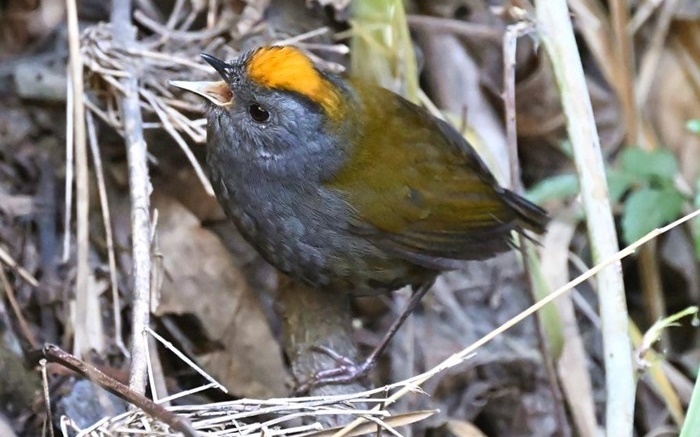
Wrenthrush was a superb encounter on the trip (photo Paul Newman).
We continued and reached the treeline at the famous antennas, where we looked for two main targets, Volcano Junco and Timberline Wren. It took time to find the junco because it was not near the base of the towers where it’s usually found, we only found it much later when it was almost time to leave, fortunately we had great views. Even though the wren was responding, it was behaving very secretively and not showing well, so we left the antennas and headed down to look in another place we knew. This time Timberline Wren came fully into view.
We headed to Paraiso Los Quetzales Lodge, where we planned to spend some time at the feeders and have lunch. The weather was great considering the time of day, it was not too sunny, and there was activity near the feeders. We found two new birds on the parking lot, Sooty Thrush, and Black-billed Nightingale-Thrush. At the feeders we got some new species and upgraded views of old friends, including eye-level and close views of Flame-throated Warbler and Spangled-cheeked Tanager, as well as Black-thighed Grosbeak, Black-capped Flycatcher, and Black-and-yellow Phainoptila (also known as Black-and-yellow Silky-flycatcher). The hummingbird feeders were a blast, even though we had already seen all the species on previous days at different locations. The number of hummingbirds and how close the Fiery-throated Hummingbirds were approaching us was amazing. A couple of young Volcano Hummingbird males were noticed amongst all the hummers buzzing around.
After a tasty lunch, we started the long drive to El Paraiso. On the way, we took a detour to some coffee plantations, where we had splendid views of the endemic Cabanis’s Ground Sparrow. It was previously considered part of Prevost Ground Sparrow (from northern Central America and Mexico) but was split not long ago. It’s named after Jean Louis Cabanis, a 19th century German ornithologist. We also managed to see Yellow-faced Grassquit, Buff-throated Saltator and Swallow-tailed Kite. We went to El Paraiso’s main town square, looking for Barn Owl roosting on palm trees, but sadly it wasn’t there. The town was preparing for an upcoming religious celebration and there was quite a crowd, nevertheless, we managed views of Finsch’s Parakeet and White-winged Dove (whoo-whoo-whoo). We retreated to our hotel to rest and prepare for another day full of adventure.
Day 10, 6th April 2023. Rio Macho and transfer to La Quinta Lodge
It didn’t take long before we scored our first target, White-eared Ground Sparrow, on the coffee plantations on the way up to Rio Macho Reserve. The weather was good and we saw birds previously seen, like Squirrel Cuckoo, Brown Jay, and Mountain Elaenia. We also got some new birds, including the spectacular White-winged Tanager, a glimpse of Speckled Tanager, and Golden-browed Chlorophonia,a real treat for the whole group! Other birds included Black-headed Saltator, Social, Piratic and Boat-billed Flycatchers, Tropical Parula, Red-faced Spinetail, Rufous-browed Peppershrike was heard constantly but never came into full view, Slate-throated Whitestart, Brown-capped Vireo, Masked Tityra, Chestnut-headed Oropendola, and Blackburnian, Tennessee and Wilson’s Warblers.
We started the drive towards the Caribbean foothills and had spectacular views of White-tailed Kite hovering for extended times, while we enjoyed a delicious lunch somewhere along the road. We arrived at our lodge in Sarapiquí in the afternoon.
Day 11, 7th April 2023. La Selva Biological Station and Sarapiquí
Today was a busy day. We left the lodge just before dawn in order to arrive at the entrance to the famous La Selva Biological Station at the right time. We spent a great couple of hours before the reserve opened, finding Rufous Motmot, Chestnut-colored Woodpecker, Pale-billed Woodpecker, Fasciated Antshrike (female), Grey-capped Flycatcher, Cinnamon Becard, Buff-throated Saltator, Golden-hooded, Blue-grey, Palm and Scarlet-rumped Tanagers, Blue Dacnis, Green Honeycreeper, Cocoa Woodcreeper, Collared Aracari, Yellow-throated Toucan, Gartered Trogon, and Red-lored Amazon flying-by. Around the parking lot we got two great species, the handsome Keel-billed Toucan,and Snowy Cotinga (male) giving great scope views.
We walked the forest trails with a resident guide who helped us find birds and wildlife. During three hours enjoyed on different trails, we found Crested Guan, Broad-billed Motmot, Hook-billed Kite, Purple-throated Fruitcrow, Buff-rumped Warbler, Chestnut-sided Warbler, Black-faced Grosbeak and Rufous-winged Woodpecker. We had good views of Hoffmann’s two-toed Sloth, Panamanian White-faced Capuchin, Collared Peccary, Strawberry Poison Dart Frog and Green and Black Poison Dart Frog.
We returned to the hotel around 11.30am, and enjoyed a very welcome lunch. After the meal, some folks had a siesta, while others spent time at the lodge feeders and got the usual suspects, and also a new bird for the trip, Red-throated Ant Tanager.
In the afternoon we explored the Sarapiquí surroundings, where we looked for Great Green Macaw coming to roost, and we had great scope views of at least two couples flying and roosting nearby. I was unhappy to see that the whole area near the roosting tree is being transformed into a few plots, likely for building houses.
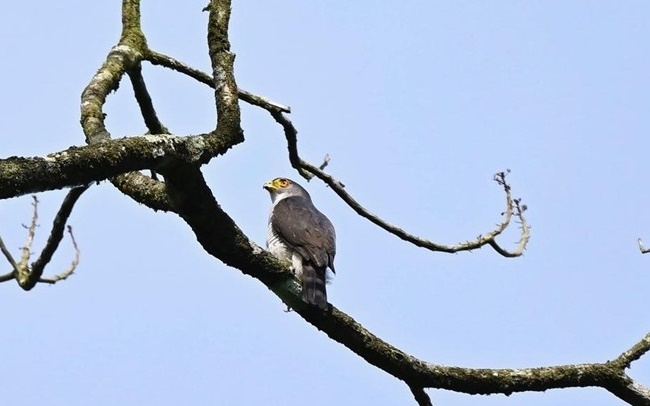
Tiny Hawk was a welcome surprise at Tapirus Lodge (photo Paul Newman).
Day 12, 8th April 2023. Tapirus Lodge and Cope feeders
Today we went to explore the Tapirus Lodge zipline and cable car complex. This seems to be a good area for the Bare-necked Umbrellabird and Baird’s Tapir, which are commonly seen in the area. Hummingbird activity was really poor, and the sunny weather did not provide much mixed feeding flock activity. We explored some of the trails, when suddenly we spotted a small raptor on a tree and were very happy to find it was the secretive Tiny Hawk, a seldom-seen Neotropical Accipiter. We had excellent views, little knowing that this was going to turn out to be a fine raptor morning.
We returned to near the lodge, where we saw a Baird’s Tapir and a Brown-throated Sloth. We walked along the steep, paved main road up to the entrance, where we found a flock with Carmiol’s Tanager (named after Julian and Francisco Carmiol, 19th century French ornithologists and collectors), together with Tawny-crested Tanager, which was unfortunately only seen by a few people, including Tim, because they kept far away inside the bushes. We arrived at the view point, where we got good views of White Hawk, which was new for the trip and, unexpectedly, Black Hawk-Eagle,which, after some persistence on our part, came down and perched for us. It was a really cool moment.
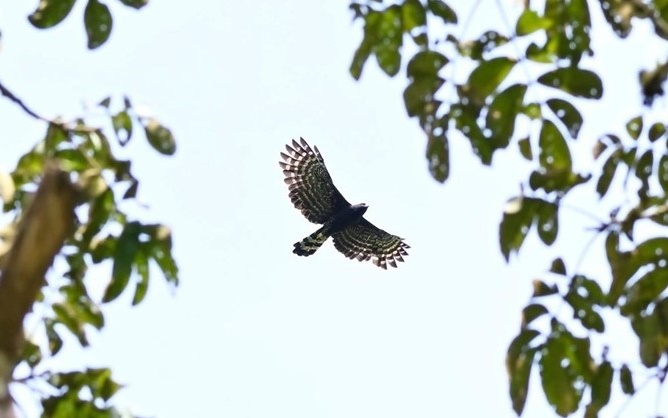
Black Hawk-Eagle gave us a great show at Tapirus Lodge (photo Paul Newman).
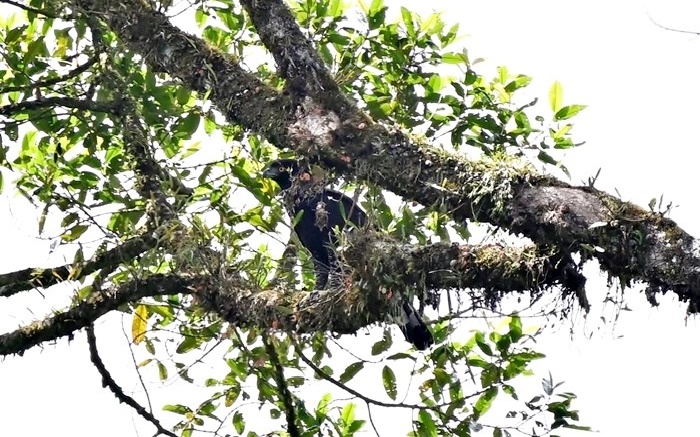
Black Hawk-Eagle at Tapirus Lodge (photo Paul Newman).
Good news was that the well-known Butterfly House (El Tapir garden) was open again for visitors and we arrived at the best time of the year for breathtaking views of the splendid Snowcap. Our short visit was rewarded with views of two males and one female. Barbara was happy with the Snowcap. Other (common) hummingbirds were Violet-headed and Rufous-tailed Hummingbirds, and Green Thorntail, which was new for the trip.
We went for lunch and then explored the classic “Donde Cope”, where we looked for birds outside the property first, before going to the feeders. We drove to the forest and started the short but slow walk along the muddy trail where, with luck, we would find the usual targets. The effort paid off well, as we got great views of both Crested and Spectacled Owls. The group was happy and we enjoyed also finding Honduran Ghost Bat. We left the forest thinking about the Credence Clearwater Revival song “Run through the Jungle”. We went to the open fields to look in a place where the rare Central American Pygmy Owl was seen last year, but sadly there was nothing.
On our way back to the house, we got our first Crimson-collared Tanager, and when we arrived, we had brilliant views of Shining, Green and lots of Red-legged Honeycreepers, all at eye-level. We enjoyed Collared Aracari, Montezuma and Chestnut-headed Oropendolas, Orange-chinned Parakeets, Red-winged Blackbird, Pale-vented Pigeons, Rufous-naped Wood Rail and Giant Cowbird.
The hummingbird feeders provided White-necked Jacobins, Bronze-tailed Plumeleteer and Stripe-throated Hermit, which had been missed by some at Esquinas Lodge. We also had views of the Smooth Helmeted Iguana,which is a classic find at Cope’s property. After a long but rewarding day we returned to our lodge.
Day 13, 9th April 2023. La Virgen, Cinchona feeders, La Paz Waterfalls and transfer to Arenal
Today we left Sarapiqui and headed to La Virgen del Socorro area to look for our first target, with nine pairs of eyes scanning the river, and we scored good views of American Dipper. We also got Torrent Tyrannulet, Black Phoebe and Northern Tufted Flycatcher, which was unfortunately only seen by a few.
Birding the forest near the river provided good new species, including our first Emerald Tanager, followed by Bay-headed, Silver-throated, Summer and Golden-hooded Tanagers, Black-throated Green and Golden-winged Warblers, Common Bush-Tanager (also called Common Chlorospingus, here in the race regionalis), Russet Antshrike, and great views of our first Scarlet-thighed Dacnis. We got more Blue Dacnis, Green and Red-legged Honeycreepers, Bananaquit, Black-faced Grosbeak, and Black-headed Saltator. We got great views of the diminutive Scale-crested Pygmy Tyrant and Blue-throated Toucanet.
We left the forest and headed to the Cinchona feeders, where we spent some exciting time enjoying birds such as Prong-billed Barbet, Crimson-collared Tanager, Blue-throated Toucanet, and other usual suspects, such as Tennessee and Chestnut-sided Warblers, Baltimore Oriole, Squirrel Cuckoo and Cinnamon-bellied Saltator. We also saw more of the birds we’d seen earlier in the morning at Virgen del Socorro, including several tanagers and saltators. Sadly, there was no sign of Red-headed Barbet, Black Guan or Buff-fronted Quail-Dove, but we consoled ourselves with great views of Brown-billed Scythebill, which was new for Eduardo’s Costa Rica list.
We moved to La Paz Waterfalls restaurant and tourist complex, where we spent some time birding around the area and enjoying the hummingbird feeders. Feeders have been returned to the complex (after being retired in 2021/2022) and we enjoyed views of Violet Sabrewing, Black-bellied Hummingbird, the endemic Coppery-headed Hummingbird, Green-crowned Brilliant, Purple-throated Mountaingem and Green Thorntail. Most of the other birds were the usual suspects, including good views of Red-tailed Hawk. We added Sooty-faced Finch, Slaty-backed Nightingale-Thrush, and Black-eared Warbler (also known as Costa Rican Warbler), which is a split from Three-striped Warbler Basileuterus tristriatus and is only found in Costa Rica and western Panama.
After a tasty lunch we headed towards La Fortuna and immediately went to Sendero Bogarin, where we tried for White-throated Crake. Sadly, the place was full of noisy visitors and staff and we didn’t see the bird, just like on our previous trips. Nevertheless, we were compensated by the sight of a pair of Black-and-white Owls roosting at daytime. We knew the owls were in a tree and Christiane was first to spot them! Everyone was happy. We even tried for the elusive Uniform Crake, which did respond, but only Mary got a glimpse of it. Other birds seen here included Smoky-brown Woodpecker and Streak-headed Woodcreeper. We finished the day and went to the comfortable Arenal Observatory Lodge for two overnights.
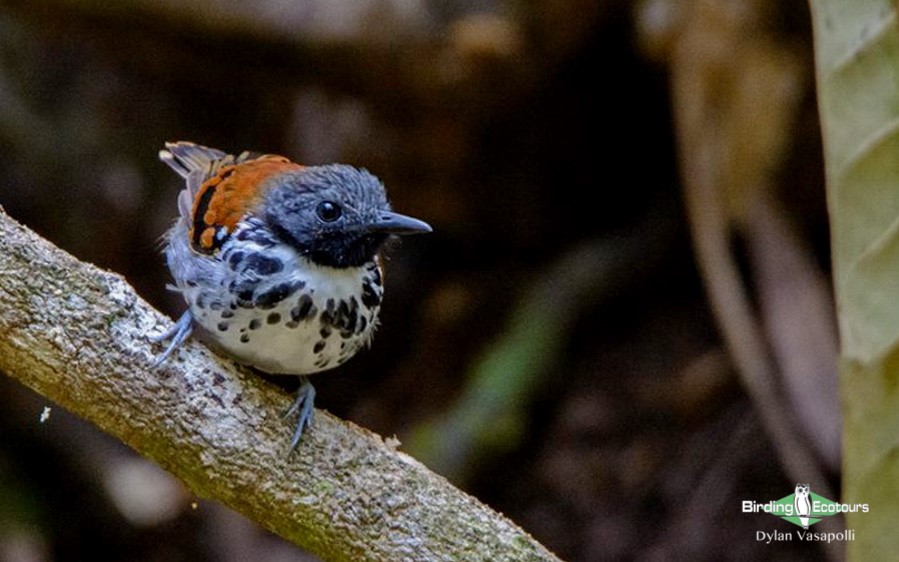
Spotted Antbird was seen at El Arenal Lodge.
Day 14, 10th April 2023. Full day at Arenal Observatory Lodge
We spent the day birding around the lodge. We looked for army-ant swarms along the waterfall trail but despite all our efforts, the ants were not to be found. Nevertheless, Spotted Antbird was very active at the beginning of the trail and we had excellent views. During the walk we also found Golden-crowned Warblers, the elusive Stripe-breasted Wren, White-flanked Antwren, Russet Antshrike, and got great views of Song Wren.
When we returned to the lodge, we checked the feeders out. We managed birds such as Grey-headed Chachalaca, Great Curassows, Emerald Tanager (the best view of the trip), Scarlet-thighed Dacnis, and the usuals: Bay-headed, Palm, Blue-grey, Scarlet, Scarlet-rumped and Golden-hooded Tanagers, as well as Green and Red-legged Honeycreepers. In the late morning we spent some time looking for Black-crested Coquette in the lodge gardens, and we got a couple of females but struggled to find the male. A nice Golden-olive Woodpecker showed up in the area.
In the afternoon we left the lodge and explored a busy road where we managed to find another of our targets, Keel-billed Motmot, which showed nicely for everyone. We saw lots of birds at El Arenal and also had our first encounter with Central American Spider Monkeys. We needed to get ready for a long day next day, so we did the checklist before supper, and went to bed after supper.
Day 15, 11th April 2023. Arenal Skyline and transfer to Medio Queso and Caño Negro
Today was to be a very busy day. We started our morning birding the lodge grounds, looking for the male Black-crested Coquette. We found good birds near the old house, including Long-tailed Tyrant, Black-crowned Tityra, Dusky Antbird, Grey-capped Flycatcher, Montezuma Oropendola and at almost the last moment we found a male Black-crested Coquette to make everyone happy.
We returned to the lodge for breakfast and then left for the Arenal Skyline. This complex is in good forest and offers excellent birding opportunities but sadly only opens after 8am. The best plan was to spend the morning birding the trails and crossing the suspended bridges, where in the past I have had great success.
On this occasion, though, I had the added pressure of trying to repeat my 2020 achievement of finding the majestic Ornate Hawk-Eagle, even though this time we didn’t have a full morning, we only had two hours to get there, try, and get out. Generally, one leaves birds like this to chance, or if you know they have been seen recently, or if there is an active nest. This trip was going so well, with such excellent people providing so many good vibes, and the birds were showing so well that I thought “If you want to see this one – which I can’t guarantee but I promise I will do my best – we have a chance in the place where I saw it in front of me at eye-level about 3 years ago.” Due to time constraints we would need to sacrifice other birds, including trying for Thicket Antpitta which was heard in the area, and other specials like Half-collared Gnatwren. We went directly to the viewpoint I knew, taking about 20 minutes to get there. Once there, I checked and scanned the whole area, and we didn’t see any large bird roosting, but we managed to see White Hawk and Great Black Hawk flying high above the forest. I tried for Sharpbill and Yellow-eared Toucanet and then played for the Ornate Hawk-Eagle, but none of them responded. A real moment of frustration came when a crowd arrived and took over the viewpoint, so we had to leave and wait for them to get their selfies and go again. In the meantime, we were trying for birds outside the viewpoint and some of us got Carmiol’s Tanager, Gartered Trogon and Ochre-bellied Flycatcher. Once the place was ours again, we continued trying until we got an answer that made our hearts beat faster and our hopes soar. We kept trying – in reality it could not have been longer than an hour and a half – but it felt like we’d been there for centuries, especially when the whole group (including myself) were watching in one direction and, from behind, the bird flew in front of us, towards the forest, and disappeared among the trees. It was no more than a glimpse of a brown raptor.
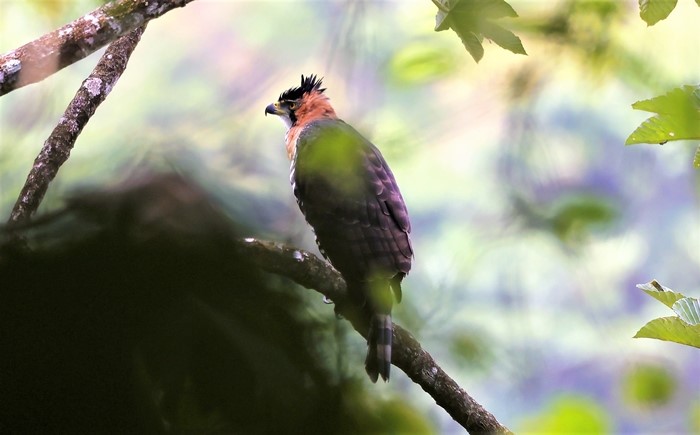
Seeing Ornate Hawk-Eagle was perhaps the most memorable moment of the tour (photo Christiane Maluche).
It was well-adapted to fly in the forest. How had it approached us so silently? Was that glimpse going to be all? No more chances? It seemed so, because it didn’t respond again for some time. We didn’t give up, we moved out from the viewpoint and started to call it from the forest. We checked other trees, and several minutes later, just before we would have to leave, I saw Paul motionless, almost in shock when he pointed out the bird he really wanted to see more than anything else on the trip. It was one of the highlights for several participants, there it was! The majestic Ornate Hawk-Eagle was sitting neither close nor far, we had to huddle together to see it between the trees, but we ended with the sweet taste of victory!
We left the place and had a tasty lunch on the way to Medio Queso wetlands, near the Nicaraguan border, where our boat man was waiting for us. This boat trip was another highlight of the trip, the birding was dynamite, with target after target and bird after bird. We started with all the expected aquatic species, which we had seen before at Tarcoles, including Blue-winged Teal, Pied-billed Grebe, Common and Purple Gallinules, Black-necked Stilt, Northern Jacana, Jabiru, Wood Stork, Anhinga, Neotropic Cormorant, Bare-throated Tiger Heron, Green Ibis, Boat-billed Heron, Tricolored Heron, Ringed, Amazon and Green Kingfishers, Black-collared Hawk, as well as abundant numbers of Great Blue Heron, Great and Snowy Egrets, and Little-blue Heron. The targets didn’t hesitate in showing up, and we started with great views of Pinnated Bittern showing well for all of us. Then we continued with views of Least Bittern and Olive-throated Parakeet, followed by “out of this world” views of Yellow-breasted Crake. We continued the boat ride to the opposite side of the wetland, where we found the near endemic Nicaraguan Grackle, we worked hard for the skulking Slaty Spinetail, we had great views of Canebrake Wren (the last from the three splits of the former Plain Wren), Grey-crowned Yellowthroat provided wonderful views, Ruddy-breasted Seedeater and, just before sunset, we crowned the day with a super adult male Nicaraguan Seed Finch and superb views of Sora walking among the water lilies.
We returned to the dock, where we said goodbye to the boat driver, and met Luis for the long drive to our final destination, Refugio Caño Negro Lodge. We arrived at dusk and went immediately to supper and then to bed.
Day 16, 12th April 2023. Boat trip to Caño Negro and transfer to La Ensenada Lodge
Today our last boat trip was planned, to explore the famous Caño Negro River. We didn’t have much time but we did have the advantage that we had already visited Tarcoles and Medio Queso. This meant we could focus our efforts on only finding the specials, and this morning we were after Sungrebe, which, together with African Finfoot Podica senegalensis and Masked Finfoot Heliopais personatus, constitute the only three members in the whole world of the family Heliornithidae. Sungrebe would be a lifer for all participants.
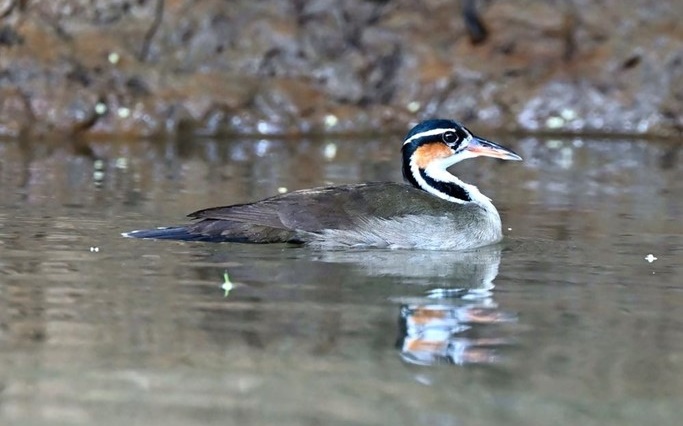
Sungrebe was another highlight of the trip (photo Paul Newman).
We had views of classic aquatic species and the usual suspects, including some new species like Muscovy Duck, the monotypic Limpkin, Green Ibis, American Pygmy Kingfisher, and also Olive-throated Parakeet, Slaty-tailed and Black-headed Trogons, Cinnamon Becard, Spot-breasted Wren, and further views of Roseate Spoonbill flying by. We tried for the most-wanted Bare-crowned Antbird from the boat, but sadly it stayed away from the shore and there was nowhere for us to get out of the boat at the spot where it was calling. Nevertheless, we were compensated with first class views of Sungrebe, which quickly rose high on the list of trip highlights. Regarding wildlife, we found an adult Green Basilisk and we saw Jaguar tracks on the shore.
We returned to the lodge to fetch our luggage and started the drive towards La Ensenada Lodge, located on the shores of the Pacific Ocean. Albeit tricky to get to the lodge, its location was ideal, between the ocean and xerophytic and dry habitats. Before we arrived at the lodge we got a few Stripe-headed Sparrows along the road, one of the few birds we had missed on the first day at Guacimo. We arrived at the lodge and the first thing waiting for us was a Pacific Screech Owl roosting at day time!
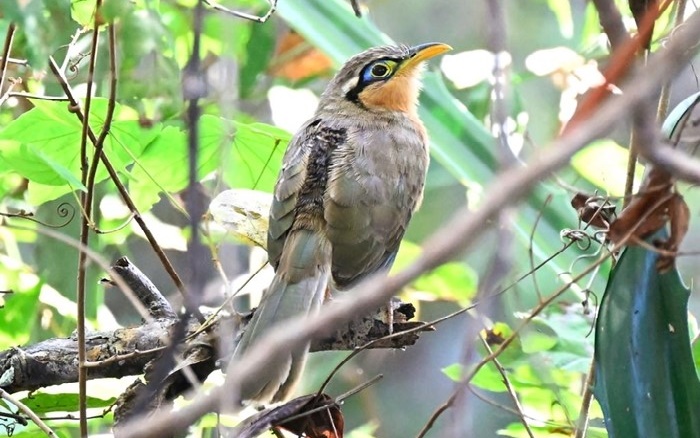
We had a magical encounter with Lesser Ground Cuckoo (photo Paul Newman).
The group decided to relax in the afternoon. Nancy and Jack called me to join a party, and the celebratory atmosphere soon spread. We could indeed celebrate an amazing trip, but we were also well aware that we still had one more target to get.
Day 17, 13th April 2023. La Ensenada Lodge and transfer to San Jose
Today we checked the mudflats near the lodge, normally host to many birds including waders, but at this time of the year many had already left. We managed to encounter Stilt Sandpipers, which are always interesting to see, and were new for some participants. Additionally, we saw Semipalmated Sandpiper, Greater Yellowlegs, Semipalmated Plover, Yellow-crowned Night Heron, Black-bellied Whistling Duck, Blue-winged Teal, Northern Jacanas, Southern Lapwings, Zone-tailed Hawk, and Wood Stork.
After checking the mudflats we started looking for the secretive and most wanted Lesser Ground Cuckoo, a really hard bird to find. We looked for suitable habitat and tried and tried until we got a response. Adrenaline spiked, but the bird call sounded like it was far away, calling from a bush and not moving. Suddenly, a participant saw motion, adrenaline spiked again, and we managed to see a distant silhouette, which disappeared quickly. It seemed like the show was over but we wanted the tour to end on a high note, so we kept trying and changed position. Suddenly – we didn’t even see it coming – the bird was sitting in front of us! That was surreal and we were ecstatic!
We returned to the lodge for breakfast, then started the drive back to San Jose and our hotel near the airport. We made a few stops along the way to try for Mangrove Cuckoo and Mangrove Rail, but it was too hot and too late. We arrived at a nice restaurant for lunch, and some participants did some shopping. Back at our hotel we said goodbye to our driver, who had done such a remarkable job for the last sixteen days.
We celebrated our last supper together as a group, enjoyed a few drinks, and reviewed our checklist, also slightly sad that our trip was finally over. It was the first time birding in Latin America for several participants, and we discussed potential future tours, perhaps to Ecuador or Brazil. It would indeed be a pleasure to travel with this group of people again, one of my best tours ever! Costa Rica Pura Vida!
Day 18, 14th April 2023. Transfer to the airport and international flights
This morning participants were taken to the airport at different times to catch their flights back home.
Bird List – Following IOC (12.2)
Birds ‘heard only’ are marked with (H) after the common name, all other species were seen.
The following notation after species names is used to show conservation status following BirdLife International: VU = Vulnerable.
| Common name | Scientific name |
| Tinamous (Tinamidae) | |
| Great Tinamou (H) | Tinamus major |
| Ducks, Geese, Swans (Anatidae) | |
| Black-bellied Whistling Duck | Dendrocygna autumnalis |
| Muscovy Duck | Cairina moschata |
| Blue-winged Teal | Spatula discors |
| Chachalacas, Curassows, Guans (Cracidae) | |
| Grey-headed Chachalaca | Ortalis cinereiceps |
| Crested Guan | Penelope purpurascens |
| Great Curassow – VU | Crax rubra |
| New World Quail (Odontophoridae) | |
| Spotted Wood Quail | Odontophorus guttatus |
| Nightjars (Caprimulgidae) | |
| Pauraque | Nyctidromus albicollis |
| Dusky Nightjar | Antrostomus saturatus |
| Potoos (Nyctibiidae) | |
| Common Potoo | Nyctibius griseus |
| Swifts (Apodidae) | |
| White-collared Swift | Streptoprocne zonaris |
| Grey-rumped Swift | Chaetura cinereiventris |
| Costa Rican Swift | Chaetura fumosa |
| Hummingbirds (Trochilidae) | |
| White-necked Jacobin | Florisuga mellivora |
| Bronzy Hermit | Glaucis aeneus |
| Stripe-throated Hermit | Phaethornis striigularis |
| Green Hermit | Phaethornis guy |
| Long-billed Hermit | Phaethornis longirostris |
| Brown Violetear | Colibri delphinae |
| Lesser Violetear | Colibri cyanotus |
| Purple-crowned Fairy | Heliothryx barroti |
| Green-breasted Mango | Anthracothorax prevostii |
| Green Thorntail | Discosura conversii |
| Black-crested Coquette | Lophornis helenae |
| Talamanca Hummingbird | Eugenes spectabilis |
| Fiery-throated Hummingbird | Panterpe insignis |
| Plain-capped Starthroat | Heliomaster constantii |
| Purple-throated Mountaingem | Lampornis calolaemus |
| Grey-tailed Mountaingem (Endemic) | Lampornis cinereicauda |
| Volcano Hummingbird | Selasphorus flammula |
| Violet-headed Hummingbird | Klais guimeti |
| Violet Sabrewing | Campylopterus hemileucurus |
| Bronze-tailed Plumeleteer | Chalybura urochrysia |
| Crowned Woodnymph | Thalurania colombica |
| Snowcap | Microchera albocoronata |
| Coppery-headed Emerald (Endemic) | Microchera cupreiceps |
| White-tailed Emerald | Microchera chionura |
| Stripe-tailed Hummingbird | Eupherusa eximia |
| Black-bellied Hummingbird | Eupherusa nigriventris |
| Scaly-breasted Hummingbird | Phaeochroa cuvierii |
| Cinnamon Hummingbird | Amazilia rutila |
| Rufous-tailed Hummingbird | Amazilia tzacatl |
| Mangrove Hummingbird (Endemic) – EN | Amazilia boucardi |
| Sapphire-throated Hummingbird | Chrysuronia coeruleogularis |
| Charming Hummingbird | Polyerata decora |
| Blue-throated Sapphire | Chlorestes eliciae |
| Cuckoos (Cuculidae) | |
| Smooth-billed Ani | Crotophaga ani |
| Groove-billed Ani | Crotophaga sulcirostris |
| Striped Cuckoo | Tapera naevia |
| Lesser Ground Cuckoo | Morococcyx erythropygus |
| Squirrel Cuckoo | Piaya cayana |
| Pigeons, Doves (Columbidae) | |
| Rock Dove (Introduced) | Columba livia |
| Pale-vented Pigeon | Patagioenas cayennensis |
| Red-billed Pigeon | Patagioenas flavirostris |
| Ruddy Pigeon – VU | Patagioenas subvinacea |
| Short-billed Pigeon | Patagioenas nigrirostris |
| Inca Dove | Columbina inca |
| Common Ground Dove | Columbina passerina |
| Ruddy Ground Dove | Columbina talpacoti |
| Blue Ground Dove | Claravis pretiosa |
| White-tipped Dove | Leptotila verreauxi |
| Grey-chested Dove | Leptotila cassinii |
| White-winged Dove | Zenaida asiática |
| Finfoots (Heliornithidae) | |
| Sungrebe | Heliornis fulica |
| Rails, Crakes & Coots (Rallidae) | |
| Uniform Crake | Amaurolimnas concolor |
| Russet-naped Wood Rail | Aramides albiventris |
| Grey-cowled Wood Rail | Aramides cajaneus |
| Sora | Porzana carolina |
| Common Gallinule | Gallinula galeata |
| Purple Gallinule | Porphyrio martinica |
| Yellow-breasted Crake | Laterallus flaviventer |
| White-throated Crake (H) | Laterallus albigularis |
| Limpkin (Aramidae) | |
| Limpkin | Aramus guarauna |
| Grebes (Podicipedidae) | |
| Pied-billed Grebe | Podilymbus podiceps |
| Stone-curlews, Thick-knees (Burhinidae) | |
| Double-striped Thick-knee | Burhinus bistriatus |
| Stilts, Avocets (Recurvirostridae) | |
| Black-necked Stilt | Himantopus mexicanus |
| Plovers (Charadriidae) | |
| Southern Lapwing | Vanellus chilensis |
| Semipalmated Plover | Charadrius semipalmatus |
| Jacanas (Jacanidae) | |
| Northern Jacana | Jacana spinosa |
| Sunbittern (Eurypygidae) | |
| Sunbittern | Eurypyga helias |
| Sandpipers, Snipes (Scolopacidae) | |
| Hudsonian Whimbrel | Numenius hudsonicus |
| Stilt Sandpiper | Calidris himantopus |
| Least Sandpiper | Calidris minutilla |
| Semipalmated Sandpiper | Calidris pusilla |
| Spotted Sandpiper | Actitis macularius |
| Greater Yellowlegs | Tringa melanoleuca |
| Gulls, Terns, Skimmers (Laridae) | |
| Caspian Tern | Hydroprogne caspia |
| Royal Tern | Thalasseus maximus |
| Storks (Ciconiidae) | |
| Jabiru | Jabiru mycteria |
| Frigatebirds (Fregatidae) | |
| Magnificent Frigatebird | Fregata magnificens |
| Great Frigatebird | Fregata minor |
| Anhingas, Darters (Anhingidae) | |
| Anhinga | Anhinga anhinga |
| Cormorants, Shags (Phalacrocoracidae) | |
| Neotropic Cormorant | Nannopterum brasilianum |
| Ibises, Spoonbills (Threskiornithidae) | |
| Green Ibis | Mesembrinibis cayennensis |
| American White Ibis | Eudocimus albus |
| Roseate Spoonbill | Platalea ajaja |
| Herons, Bitterns (Ardeidae) | |
| Rufescent Tiger Heron | Tigrisoma lineatum |
| Fasciated Tiger Heron | Tigrisoma fasciatum |
| Bare-throated Tiger Heron | Tigrisoma mexicanum |
| Boat-billed Heron | Cochlearius cochlearius |
| Pinnated Bittern | Botaurus pinnatus |
| Least Bittern | Ixobrychus exilis |
| Black-crowned Night Heron | Nycticorax nycticorax |
| Yellow-crowned Night Heron | Nyctanassa violácea |
| Green Heron | Butorides virescens |
| Western Cattle Egret | Bubulcus ibis |
| Great Blue Heron | Ardea herodias |
| Great Egret | Ardea alba |
| Tricolored Heron | Egretta tricolor |
| Little Blue Heron | Egretta caerulea |
| Snowy Egret | Egretta thula |
| Pelicans (Pelecanidae) | |
| Brown Pelican | Pelecanus occidentalis |
| New World Vultures (Cathartidae) | |
| King Vulture | Sarcoramphus papa |
| Black Vulture | Coragyps atratus |
| Turkey Vulture | Cathartes aura |
| Lesser Yellow-headed Vulture | Cathartes burrovianus |
| Ospreys (Pandionidae) | |
| Western Osprey | Pandion haliaetus |
| Kites, Hawks, Eagles (Accipitridae) | |
| White-tailed Kite | Elanus leucurus |
| Hook-billed Kite | Chondrohierax uncinatus |
| Swallow-tailed Kite | Elanoides forficatus |
| Black Hawk-Eagle | Spizaetus tyrannus |
| Ornate Hawk-Eagle | Spizaetus ornatus |
| Double-toothed Kite | Harpagus bidentatus |
| Tiny Hawk | Accipiter superciliosus |
| Plumbeous Kite | Ictinia plúmbea |
| Black-collared Hawk | Busarellus nigricollis |
| Snail Kite | Rostrhamus sociabilis |
| Common Black Hawk | Buteogallus anthracinus |
| Savanna Hawk | Buteogallus meridionalis |
| Great Black Hawk | Buteogallus urubitinga |
| Roadside Hawk | Rupornis magnirostris |
| White Hawk | Pseudastur albicollis |
| Grey Hawk | Buteo plagiatus |
| Grey-lined Hawk | Buteo nitidus |
| Broad-winged Hawk | Buteo platypterus |
| Short-tailed Hawk | Buteo brachyurus |
| Zone-tailed Hawk | Buteo albonotatus |
| Red-tailed Hawk | Buteo jamaicensis |
| Owls (Strigidae) | |
| Unspotted Saw-whet Owl (H) | Aegolius ridgwayi |
| Ferruginous Pygmy Owl | Glaucidium brasilianum |
| Striped Owl | Asio clamator |
| Pacific Screech Owl | Megascops cooperi |
| Spectacled Owl | Pulsatrix perspicillata |
| Crested Owl | Lophostrix cristata |
| Black-and-white Owl | Strix nigrolineata |
| Trogons (Trogonidae) | |
| Resplendent Quetzal | Pharomachrus mocinno |
| Slaty-tailed Trogon | Trogon massena |
| Black-headed Trogon | Trogon melanocephalus |
| Baird’s Trogon | Trogon bairdii |
| Gartered Trogon | Trogon caligatus |
| Black-throated Trogon | Trogon Rufus |
| Kingfishers (Alcedinidae) | |
| Amazon Kingfisher | Chloroceryle amazona |
| American Pygmy Kingfisher | Chloroceryle aenea |
| Green Kingfisher | Chloroceryle americana |
| Ringed Kingfisher | Megaceryle torquata |
| Belted Kingfisher | Megaceryle alcyon |
| Motmots (Momotidae) | |
| Lesson’s Motmot | Momotus lessonii |
| Rufous Motmot | Baryphthengus martii |
| Keel-billed Motmot – VU | Electron carinatum |
| Broad-billed Motmot | Electron platyrhynchum |
| Turquoise-browed Motmot | Eumomota superciliosa |
| Jacamars (Galbulidae) | |
| Rufous-tailed Jacamar | Galbula ruficauda |
| Puffbirds (Bucconidae) | |
| White-whiskered Puffbird | Malacoptila panamensis |
| Toucan Barbets (Semnornithidae) | |
| Prong-billed Barbet | Semnornis frantzii |
| Toucans (Ramphastidae) | |
| Blue-throated Toucanet | Aulacorhynchus caeruleogularis |
| Collared Aracari | Pteroglossus torquatus |
| Fiery-billed Aracari | Pteroglossus frantzii |
| Keel-billed Toucan | Ramphastos sulfuratus |
| Yellow-throated Toucan | Ramphastos ambiguus |
| Woodpeckers (Picidae) | |
| Olivaceous Piculet | Picumnus olivaceus |
| Acorn Woodpecker | Melanerpes formicivorus |
| Golden-naped Woodpecker | Melanerpes chrysauchen |
| Black-cheeked Woodpecker | Melanerpes pucherani |
| Red-crowned Woodpecker | Melanerpes rubricapillus |
| Hoffmann’s Woodpecker | Melanerpes hoffmannii |
| Smoky-brown Woodpecker | Leuconotopicus fumigatus |
| Hairy Woodpecker | Leuconotopicus villosus |
| Rufous-winged Woodpecker | Piculus simplex |
| Golden-olive Woodpecker | Colaptes rubiginosus |
| Chestnut-colored Woodpecker | Celeus castaneus |
| Lineated Woodpecker | Dryocopus lineatus |
| Pale-billed Woodpecker | Campephilus guatemalensis |
| Caracaras, Falcons (Falconidae) | |
| Crested Caracara | Caracara plancus |
| Yellow-headed Caracara | Milvago chimachima |
| Laughing Falcon | Herpetotheres cachinnans |
| Collared Forest Falcon (H) | Micrastur semitorquatus |
| Bat Falcon | Falco rufigularis |
| African & New World Parrots (Psittacidae) | |
| Barred Parakeet | Bolborhynchus lineola |
| Orange-chinned Parakeet | Brotogeris jugularis |
| Blue-headed Parrot | Pionus menstruus |
| White-crowned Parrot | Pionus senilis |
| White-fronted Amazon | Amazona albifrons |
| Red-lored Amazon | Amazona autumnalis |
| Northern Mealy Amazon | Amazona guatemalae |
| Olive-throated Parakeet | Eupsittula nana |
| Orange-fronted Parakeet – VU | Eupsittula canicularis |
| Brown-throated Parakeet | Eupsittula pertinax |
| Great Green Macaw – CR | Ara ambiguus |
| Scarlet Macaw | Ara macao |
| Finsch’s Parakeet | Psittacara finschi |
| Ovenbirds (Furnariidae) | |
| Scaly-throated Leaftosser | Sclerurus guatemalensis |
| Tawny-winged Woodcreeper | Dendrocincla anabatina |
| Wedge-billed Woodcreeper | Glyphorynchus spirurus |
| Northern Barred Woodcreeper | Dendrocolaptes sanctithomae |
| Black-banded Woodcreeper | Dendrocolaptes picumnus |
| Cocoa Woodcreeper | Xiphorhynchus susurrans |
| Black-striped Woodcreeper | Xiphorhynchus lachrymosus |
| Brown-billed Scythebill | Campylorhamphus pusillus |
| Streak-headed Woodcreeper | Lepidocolaptes souleyetii |
| Spot-crowned Woodcreeper | Lepidocolaptes affinis |
| Plain Xenops | Xenops minutus |
| Buffy Tuftedcheek | Pseudocolaptes lawrencii |
| Chiriqui Foliage-gleaner | Automolus exsertus |
| Ruddy Treerunner | Margarornis rubiginosus |
| Red-faced Spinetail | Cranioleuca erythrops |
| Slaty Spinetail | Synallaxis brachyura |
| Pale-breasted Spinetail | Synallaxis albescens |
| Antbirds (Thamnophilidae) | |
| Russet Antshrike | Thamnistes anabatinus |
| Dot-winged Antwren | Microrhopias quixensis |
| Slaty Antwren | Myrmotherula schisticolor |
| Barred Antshrike | Thamnophilus doliatus |
| Black-hooded Antshrike | Thamnophilus bridgesi |
| Black-crowned Antshrike | Thamnophilus atrinucha |
| Fasciated Antshrike | Cymbilaimus lineatus |
| Great Antshrike (H) | Taraba major |
| Dusky Antbird | Cercomacroides tyrannina |
| Spotted Antbird | Hylophylax naevioides |
| Chestnut-backed Antbird | Poliocrania exsul |
| Bare-crowned Antbird (H) | Gymnocichla nudiceps |
| Antthrushes (Formicariidae) | |
| Black-faced Antthrush | Formicarius analis |
| Antpittas (Grallariidae) | |
| Streak-chested Antpitta (H) | Hylopezus perspicillatus |
| Thicket Antpitta (H) | Hylopezus dives |
| Tyrant Flycatchers, Calyptura (Tyrannidae) | |
| Greenish Elaenia | Myiopagis viridicata |
| Yellow-bellied Elaenia | Elaenia flavogaster |
| Mountain Elaenia | Elaenia frantzii |
| Southern Beardless Tyrannulet | Camptostoma obsoletum |
| Torrent Tyrannulet | Serpophaga cinérea |
| Yellow Tyrannulet | Capsiempis flaveola |
| Mistletoe Tyrannulet | Zimmerius parvus |
| Ochre-bellied Flycatcher | Mionectes oleagineus |
| Northern Bentbill | Oncostoma cinereigulare |
| Scale-crested Pygmy Tyrant | Lophotriccus pileatus |
| Common Tody-Flycatcher | Todirostrum cinereum |
| Eye-ringed Flatbill | Rhynchocyclus brevirostris |
| Yellow-margined Flatbill | Tolmomyias flavotectus |
| Golden-crowned Spadebill | Platyrinchus coronatus |
| Black Phoebe | Sayornis nigricans |
| Northern Tufted Flycatcher | Mitrephanes phaeocercus |
| Dark Pewee | Contopus lugubris |
| Tropical Pewee | Contopus cinereus |
| Yellow-bellied Flycatcher | Empidonax flaviventris |
| Yellowish Flycatcher | Empidonax flavescens |
| Black-capped Flycatcher | Empidonax atriceps |
| Long-tailed Tyrant | Colonia colonus |
| Piratic Flycatcher | Legatus leucophaius |
| Rusty-margined Flycatcher | Myiozetetes cayanensis |
| Social Flycatcher | Myiozetetes similis |
| Grey-capped Flycatcher | Myiozetetes granadensis |
| Great Kiskadee | Pitangus sulphuratus |
| Streaked Flycatcher | Myiodynastes maculatus |
| Boat-billed Flycatcher | Megarynchus pitangua |
| Tropical Kingbird | Tyrannus melancholicus |
| Fork-tailed Flycatcher | Tyrannus savana |
| Dusky-capped Flycatcher | Myiarchus tuberculifer |
| Panamanian Flycatcher | Myiarchus panamensis |
| Nutting’s Flycatcher | Myiarchus nuttingi |
| Great Crested Flycatcher | Myiarchus crinitus |
| Brown-crested Flycatcher | Myiarchus tyrannulus |
| Bright-rumped Attila | Attila spadiceus |
| Cotingas (Cotingidae) | |
| Purple-throated Fruitcrow | Querula purpurata |
| Rufous Piha | Lipaugus unirufus |
| Turquoise Cotinga – VU | Cotinga ridgwayi |
| Yellow-billed Cotinga – EN | Carpodectes antoniae |
| Snowy Cotinga | Carpodectes nitidus |
| Manakins (Pipridae) | |
| Long-tailed Manakin | Chiroxiphia linearis |
| Blue-crowned Manakin | Lepidothrix coronata |
| White-collared Manakin | Manacus candei |
| Orange-collared Manakin | Manacus aurantiacus |
| Red-capped Manakin | Ceratopipra mentalis |
| Tityras, Becards, Sharpbill (Tityridae) | |
| Northern Royal Flycatcher | Onychorhynchus mexicanus |
| Sulphur-rumped Myiobius | Myiobius sulphureipygius |
| Ruddy-tailed Flycatcher | Terenotriccus erythrurus |
| Black-crowned Tityra | Tityra inquisitor |
| Masked Tityra | Tityra semifasciata |
| Cinnamon Becard | Pachyramphus cinnamomeus |
| White-winged Becard | Pachyramphus polychopterus |
| Black-and-white Becard | Pachyramphus albogriseus |
| Rose-throated Becard | Pachyramphus aglaiae |
| Vireos, Greenlets, Shrike-babblers (Vireonidae) | |
| Rufous-browed Peppershrike (H) | Cyclarhis gujanensis |
| Scrub Greenlet | Hylophilus flavipes |
| Tawny-crowned Greenlet | Tunchiornis ochraceiceps |
| Lesser Greenlet | Pachysylvia decurtata |
| Yellow-green Vireo | Vireo flavoviridis |
| Red-eyed Vireo | Vireo olivaceus |
| Brown-capped Vireo | Vireo leucophrys |
| Yellow-throated Vireo | Vireo flavifrons |
| Yellow-winged Vireo | Vireo carmioli |
| Mangrove Vireo | Vireo pallens |
| Crows, Jays (Corvidae) | |
| Brown Jay | Psilorhinus morio |
| White-throated Magpie-Jay | Calocitta Formosa |
| Silky-flycatchers (Ptiliogonatidae) | |
| Black-and-yellow Phainoptila | Phainoptila melanoxantha |
| Long-tailed Silky-flycatcher | Ptiliogonys caudatus |
| Swallows, Martins (Hirundinidae) | |
| Mangrove Swallow | Tachycineta albilinea |
| Blue-and-white Swallow | Pygochelidon cyanoleuca |
| Northern Rough-winged Swallow | Stelgidopteryx serripennis |
| Southern Rough-winged Swallow | Stelgidopteryx ruficollis |
| Brown-chested Martin | Progne tapera |
| Grey-breasted Martin | Progne chalybea |
| Barn Swallow | Hirundo rustica |
| Wrens (Troglodytidae) | |
| Rufous-backed Wren | Campylorhynchus capistratus |
| Spot-breasted Wren | Pheugopedius maculipectus |
| Banded Wren | Thryophilus pleurostictus |
| Cabanis’s Wren | Cantorchilus modestus |
| Canebrake Wren | Cantorchilus zeledoni |
| Isthmian Wren | Cantorchilus elutus |
| Riverside Wren | Cantorchilus semibadius |
| Stripe-breasted Wren | Cantorchilus thoracicus |
| House Wren | Troglodytes aedon |
| Ochraceous Wren | Troglodytes ochraceus |
| Timberline Wren | Thryorchilus browni |
| Grey-breasted Wood Wren | Henicorhina leucophrys |
| Song Wren | Cyphorhinus phaeocephalus |
| Gnatcatchers (Polioptilidae) | |
| Trilling Gnatwren | Ramphocaenus melanurus |
| White-browed Gnatcatcher | Polioptila bilineata |
| White-lored Gnatcatcher | Polioptila albiloris |
| Mockingbirds, Thrashers (Mimidae) | |
| Tropical Mockingbird | Mimus gilvus |
| Thrushes (Turdidae) | |
| Black-faced Solitaire | Myadestes melanops |
| Wood Thrush | Hylocichla mustelina |
| Slaty-backed Nightingale-Thrush | Catharus fuscater |
| Swainson’s Thrush | Catharus ustulatus |
| Black-billed Nightingale-Thrush | Catharus gracilirostris |
| Ruddy-capped Nightingale-Thrush | Catharus frantzii |
| Sooty Thrush | Turdus nigrescens |
| Mountain Thrush | Turdus plebejus |
| Clay-colored Thrush | Turdus grayi |
| Dippers (Cinclidae) | |
| American Dipper | Cinclus mexicanus |
| Old World Sparrows, Snowfinches (Passeridae) | |
| House Sparrow (Introduced) | Passer domesticus |
| Finches, Euphonias (Fringillidae) | |
| Yellow-bellied Siskin | Spinus xanthogastrus |
| Golden-browed Chlorophonia | Chlorophonia callophrys |
| Yellow-crowned Euphonia | Euphonia luteicapilla |
| Yellow-throated Euphonia | Euphonia hirundinacea |
| Thick-billed Euphonia | Euphonia laniirostris |
| Spot-crowned Euphonia | Euphonia imitans |
| Olive-backed Euphonia | Euphonia gouldi |
| New World Sparrows (Passerellidae) | |
| Sooty-capped Bush Tanager | Chlorospingus pileatus |
| Common Bush Tanager | Chlorospingus flavopectus |
| Stripe-headed Sparrow | Peucaea ruficauda |
| Black-striped Sparrow | Arremonops conirostris |
| Olive Sparrow | Arremonops rufivirgatus |
| Orange-billed Sparrow | Arremon aurantiirostris |
| Sooty-faced Finch | Arremon crassirostris |
| Volcano Junco | Junco vulcani |
| Rufous-collared Sparrow | Zonotrichia capensis |
| Large-footed Finch | Pezopetes capitales |
| White-eared Ground Sparrow | Melozone leucotis |
| Cabanis’s Ground Sparrow (Endemic) | Melozone cabanisi |
| Yellow-thighed Brushfinch | Atlapetes tibialis |
| Wrenthrush (Zeledoniidae) | |
| Wrenthrush | Zeledonia coronata |
| Oropendolas, Orioles, Blackbirds (Icteridae) | |
| Chestnut-headed Oropendola | Psarocolius wagleri |
| Crested Oropendola | Psarocolius decumanus |
| Montezuma Oropendola | Psarocolius Montezuma |
| Scarlet-rumped Cacique | Cacicus microrhynchus |
| Streak-backed Oriole | Icterus pustulatus |
| Baltimore Oriole | Icterus gálbula |
| Spot-breasted Oriole | Icterus pectoralis |
| Black-cowled Oriole | Icterus prosthemelas |
| Red-winged Blackbird | Agelaius phoeniceus |
| Giant Cowbird | Molothrus oryzivorus |
| Bronzed Cowbird | Molothrus aeneus |
| Melodious Blackbird | Dives dives |
| Nicaraguan Grackle | Quiscalus nicaraguensis |
| Great-tailed Grackle | Quiscalus mexicanus |
| New World Warblers (Parulidae) | |
| Northern Waterthrush | Parkesia noveboracensis |
| Golden-winged Warbler | Vermivora chrysoptera |
| Black-and-white Warbler | Mniotilta varia |
| Flame-throated Warbler | Oreothlypis gutturalis |
| Tennessee Warbler | Leiothlypis peregrina |
| Grey-crowned Yellowthroat | Geothlypis poliocephala |
| Mourning Warbler | Geothlypis philadelphia |
| Kentucky Warbler | Geothlypis Formosa |
| American Redstart | Setophaga ruticilla |
| Tropical Parula | Setophaga pitiayumi |
| Blackburnian Warbler | Setophaga fusca |
| American Yellow Warbler | Setophaga aestiva |
| Mangrove Warbler | Setophaga petechia |
| Chestnut-sided Warbler | Setophaga pensylvanica |
| Black-throated Green Warbler | Setophaga virens |
| Buff-rumped Warbler | Myiothlypis fulvicauda |
| Chestnut-capped Warbler | Basileuterus delattrii |
| Black-cheeked Warbler | Basileuterus melanogenys |
| Golden-crowned Warbler | Basileuterus culicivorus |
| Black-eared Warbler | Basileuterus melanotis |
| Canada Warbler | Cardellina canadensis |
| Wilson’s Warbler | Cardellina pusilla |
| Slate-throated Whitestart | Myioborus miniatus |
| Collared Whitestart | Myioborus torquatus |
| Cardinals & Allies (Cardinalidae) | |
| Flame-colored Tanager | Piranga bidentata |
| Summer Tanager | Piranga rubra |
| Scarlet Tanager | Piranga olivácea |
| Western Tanager | Piranga ludoviciana |
| White-winged Tanager | Piranga leucoptera |
| Red-crowned Ant Tanager | Habia rubica |
| Red-throated Ant Tanager | Habia fuscicauda |
| Black-cheeked Ant Tanager (Endemic) – EN | Habia atrimaxillaris |
| Carmiol’s Tanager | Chlorothraupis carmioli |
| Black-thighed Grosbeak | Pheucticus tibialis |
| Black-faced Grosbeak | Caryothraustes poliogaster |
| Blue-black Grosbeak | Cyanoloxia cyanoides |
| Painted Bunting | Passerina ciris |
| Tanagers & Allies (Thraupidae) | |
| Green Honeycreeper | Chlorophanes spiza |
| Red-legged Honeycreeper | Cyanerpes cyaneus |
| Shining Honeycreeper | Cyanerpes lucidus |
| Scarlet-thighed Dacnis | Dacnis venusta |
| Blue Dacnis | Dacnis cayana |
| Cinnamon-bellied Saltator | Saltator grandis |
| Streaked Saltator | Saltator striatipectus |
| Buff-throated Saltator | Saltator maximus |
| Black-headed Saltator | Saltator atriceps |
| Bananaquit | Coereba flaveola |
| Yellow-faced Grassquit | Tiaris olivaceus |
| Blue-black Grassquit | Volatinia jacarina |
| Grey-headed Tanager | Eucometis penicillata |
| White-shouldered Tanager | Loriotus luctuosus |
| Tawny-crested Tanager | Tachyphonus delatrii |
| Crimson-collared Tanager | Ramphocelus sanguinolentus |
| Scarlet-rumped Tanager | Ramphocelus passerinii |
| Morelet’s Seedeater | Sporophila morelleti |
| Variable Seedeater | Sporophila corvina |
| Yellow-bellied Seedeater | Sporophila nigricollis |
| Thick-billed Seed Finch | Sporophila funérea |
| Nicaraguan Seed Finch | Sporophila nuttingi |
| Ruddy-breasted Seedeater | Sporophila minuta |
| Slaty Flowerpiercer | Diglossa plúmbea |
| Speckled Tanager | Ixothraupis guttata |
| Blue-grey Tanager | Thraupis episcopus |
| Palm Tanager | Thraupis palmarum |
| Golden-hooded Tanager | Stilpnia larvata |
| Spangle-cheeked Tanager | Tangara dowii |
| Bay-headed Tanager | Tangara gyrola |
| Emerald Tanager | Tangara florida |
| Silver-throated Tanager | Tangara icterocephala |
| Total seen | 432 |
| Total heard only | 9 |
| Total recorded | 441 |
Mammal List
The following notation after species names is used to show conservation status following the IUCN Red List of Threatened Species: EN = Endangered.
| Common name | Scientific name |
| Didelphidae | |
| Common Opossum | Didelphis marsupialis |
| Sciuridae | |
| Red-tailed Squirrel | Sciurus granatensis |
| Variegated Squirrel | Sciurus variegatoides |
| Dasyproctidae | |
| Central American Agouti | Dasyprocta punctate |
| Emballonuridae | |
| Northern Ghost Bat | Diclidurus albus |
| Greater sac-winged Bat | Saccopteryx bilineata |
| Phyllostomidae | |
| Honduran White Bat | Ectophylla alba |
| Common Tent-making Bat | Uroderma bilobatum |
| Choloepodidae | |
| Hoffmann’s two-toed Sloth | Choloepus hoffmanni |
| Bradypodidae | |
| Brown-throated Sloth | Bradypus variegatus |
| Cebidae | |
| Panamanian white-faced capuchin | Cebus imitator |
| Atelidae | |
| Mantled Howler | Alouatta palliata |
| Geoffroy’s spider monkey | Ateles geoffroyi |
| Procyonidae | |
| Northern Raccoon | Cerdocyon lotor |
| White-nosed Coati | Nasua narica |
| Mustellidae | |
| Tayra | Eira barbara |
| Neotropical Otter | Lontra longicaudis |
| Cervidae | |
| White-tailed Deer | Odocoileus virginianus |
| Tapiridae | |
| Baird’s Tapir – EN | Tapirus bairdii |
| Tayassuidae | |
| Collared Peccary | Dicotyles tajacu |
| Total seen | 20 |
Reptile List
The following notation after species names is used to show conservation status following the IUCN Red List of Threatened Species: VU = Vulnerable.
| Common name | Scientific name |
| Crocodylidae (Crocodiles) | |
| American Crocodile – VU | Crocodylus intermedius |
| Alligatoridae (Caimans and Alligators) | |
| Common [Spectacled] Caiman | Caiman crocodilus |
| Colubridae (Typical Snakes) | |
| Green Parrot Snake | Leptophis ahaetulla |
| Viperidae (Vipers) | |
| Eyelash Viper | Bothriechis schlegelii |
| Iguanidae (Iguanas) | |
| Green Iguana | Iguana iguana |
| Spiny-tailed Iguana | Ctenosaura similis |
| Corytophanidae (Helmeted Lizards, Basilisks) | |
| Smooth helmeted Iguana | Corytophanes cristatus |
| Green Basilisk | Basiliscus plumifrons |
| Common Basilisk | Basiliscus basiliscus |
| Whiptails and Tegus (Teiidae) | |
| Central American Whiptail | Holcosus festivus |
| Podocnemididae (South American River Turtle) | |
| Black Wood Turtle | Rhinoclemmys funereal |
| Emydidae (Marsh Turtles) | |
| Nicaraguan Slider | Trachemys emolli |
| Gekkonidae (Geckos) | |
| Tropical House Gecko | Hemidactylus mabouia |
| Total seen | 13 |
Amphibian List
| Common name | Scientific name |
| Dendrobatidae (Dart Frogs) | |
| Strawberry poison-dart frog | Oophaga pumilio |
| Green-and-black poison-dart frog | Dendrobates auratus |
| Hylidae (Tree Frogs) | |
| Red-eyed tree frog | Agalychnis callidryas |
| Leptodactylidae (Bull Frogs) | |
| Smoky jungle frog | Leptodactylus pentadactylus |
| Bufonidae | |
| Cane toad | Rhinella marina |
| Total seen | 5 |
This is a sample trip report. Please email us ([email protected]) for more trip reports from this destination.
